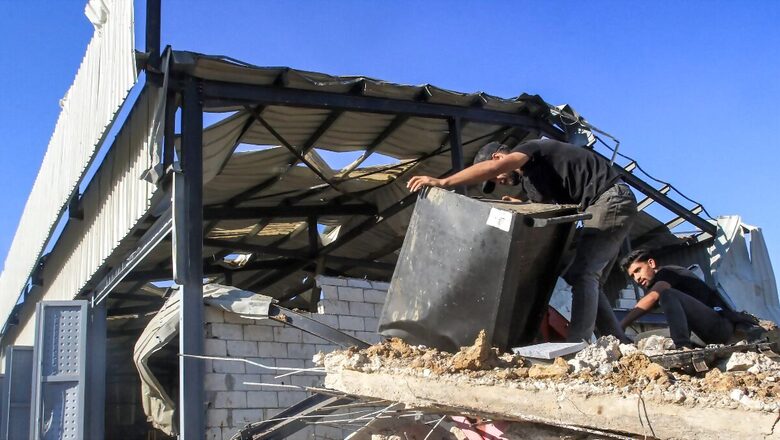
views
After almost a year of trading fire, Israel and the Lebanese militant group Hezbollah are now engaged in ferocious confrontations that threaten to turn into a full-blown war.
Israel faces a much more formidable foe in Hezbollah than it faced in Hamas in the Gaza Strip. Many consider the Iran-backed group the strongest paramilitary force in the region — but the group also has political and social wings with considerable power in Lebanon.
Founded in 1982 during Lebanon’s civil war, Hezbollah was initially devoted to ending Israel’s occupation of southern Lebanon. It achieved that in 2000 following a long war of attrition that eventually forced Israel to withdraw. However, it has continued its battle and seeks Israel’s destruction.
Shiite Muslim Hezbollah is part of a collection of Iranian-backed factions and governments known as the Axis of Resistance. It was the first group that Iran supported and used as a way to export its brand of political Islamism.
In addition to being an armed group, Hezbollah is also a political party with lawmakers in the Lebanese parliament and has had representatives in most Lebanese governments for decades. It also provides extensive social services, including running schools and health clinics, in southern Lebanon and other parts of the country where it has a strong presence.
TRACING HISTORY
Lebanon gained independence from France in 1943. Certain nationalists in the newly formed republic believed in an alliance of minorities that would see a Christian-Lebanese nation align with the Zionists.
According to Al-Jazeera, Lebanon’s founding fathers — primarily Riad al-Solh and Bechara el-Khoury — felt they could not have a relationship with Israel and maintain good relations with neighbouring Arab states. On May 14, 1948, the state of Israel declared Independence. The next day, Egypt, Syria, Jordan, Iraq and Lebanon declared war on Israel, with Lebanon having the smallest army among Arab nations.
The Israeli forces repelled the Arab fighters and temporarily occupied part of south Lebanon. An armistice was signed on March 23, 1949, and Israeli troops withdrew to the internationally recognised border.
In 1965, the emergence of a Palestinian nationalist group — Fatah — as a powerful force in the region coincided with renewed border skirmishes as the movement started launching low-intensity attacks on Israeli positions, reigniting hostilities.
The movement, however, divided people. While many in the country’s Muslim community and in the secular or pan-Arabist left sympathised with the Palestinian cause, Lebanon’s nationalist right, representing a largely Christian base, did not want to be implicated in a conflict they felt did not concern them.
In 1967, tensions between Israel and surrounding Arab states escalated into the Six-Day War on June 5 but Israel emerged victorious. As a result, Palestinians were expelled from Jerusalem, the West Bank and Gaza in what became known as the “Naksa” or the setback. Though Lebanon’s military involvement in the war was minimal, the repercussions were significant. Thousands of Palestinian refugees fled to Lebanon, and violence was incited against Lebanon’s Jewish population, leading many to emigrate.
A year later, Yasser Arafat’s Fatah took control of the Palestinian Liberation Organisation (PLO), a broad coalition representing the Palestinian people.
In 1973, on the intervening night of April 9 and 10, Israeli special forces took speedboats and landed on Lebanese beaches. They assassinated three PLO leaders. Part of Israel’s Operation Wrath of God, the raid became known in Arabic as the Verdun Massacre.
Lebanon-based Palestinian fighters continued to conduct cross-border raids, and in March 1978, Israel invaded Lebanon, advancing as far as the Litani River. In response, the United Nations Security Council passed Resolution 425, which called for the immediate withdrawal of Israeli forces. It also established the UN Interim Force in Lebanon (UNIFIL), which still operates to this day.
A year later, in 1979, a peace agreement between Egypt and Israel, stemming from the previous year’s Camp David Accords, shifts the balance of power in the Middle East.
On June 6, 1982, Israel invaded Lebanon under the pretence of stopping PLO raids across its border. The Israeli forces, however, progressed as far north as the capital Beirut, laying siege to the largely pro-Palestinian West Beirut. The invasion led to the eventual departure of the PLO from Lebanon under the supervision of a multinational peacekeeping force on September 1. The invasion also helped create Hezbollah, with the backing of Iran’s Revolutionary Guard.
In 1985, Israel withdrew to the Litani River in south Lebanon and created what it called a security zone there. The Israeli occupation of the southern region continued until 2000.
In 1993, Israel launched what it called Operation Accountability in Lebanon after Hezbollah operations killed at least five Israeli soldiers. Also known as the Seven-Day War, the conflict resulted in thousands of buildings bombed, with 118 Lebanese civilians killed and 500 more wounded.
Casualties on both sides of the Lebanon-Israel border gave rise to Operation Grapes of Wrath on April 11in 1996. Israel bombarded Lebanon with shells and air raids, resulting in the Qana Massacre of more than 100 Lebanese people, including at least 37 children. On May 24, 2000, Israel declared it would withdraw its forces to the Blue Line, its UN-designated border. The decision effectively ended the Israeli occupation of south Lebanon.
Until recently, the border had been relatively quiet. Occasional rockets or drones crossed from Lebanon into Israel without leading to serious escalation, while Israel violated Lebanese airspace more than 22,000 times from 2007 to 2022. However, Hezbollah has traded almost daily cross-border fire with Israel since Hamas’s October 7, 2023 attack on southern Israel which triggered the war in the Gaza Strip.
On September 17 and 18, hundreds of pagers and walkie-talkies used by Hezbollah for communication exploded in an operation the Lebanese militant group blamed on Israel.
Israel did not comment on the stunning security breach, which killed dozens and wounded 2,931 more, according to Lebanese authorities.
More tit-for-tat exchanges of fire followed, and on September 20 an Israeli strike on the group’s southern Beirut stronghold killed Ibrahim Aqil, the commander of Hezbollah’s elite Radwan Force. Days later on September 23, Israeli strikes pounded Lebanon’s south, killing 274 people — the worst toll by far since the war in Gaza erupted.
CRUMBLING LEBANON
Mass layoffs, hospitals threatened with closure, shuttered shops and restaurants, crimes driven by desperation, a military that can no longer afford to feed its soldiers meat and warehouses that sell expired poultry — Lebanon is hurtling toward a tipping point at an alarming speed, driven by financial ruin, collapsing institutions, hyperinflation and rapidly rising poverty, the Associated Press reported.
In the past, Lebanon has been able to in part blame its turmoil on outsiders. With 18 religious sects, a weak central government and far more powerful neighbours, it has always been caught in regional rivalries leading to political paralysis, violence or both. Its 1975-90 civil war made the word “Beirut” synonymous with war’s devastation, writes foreign affairs analyst and journalist Zeina Karam.
Now, with the threat of a wider war, Lebanon has scrambled to equip hospitals with supplies and prepare public schools to open up to people seeking shelter. The Lebanese government said that funding for the emergency will come from creditors and humanitarian aid organizations. But the authorities have struggled to find money to care for 100,000 currently displaced and an estimated 60,000 people living in conflict areas, which is costing about $24 million a month.
Decades of corruption and political paralysis have left Lebanon’s banks barely functional, while electricity services are almost entirely in the hands of private diesel-run generator owners and fuel suppliers. Public service institutions rely on aid groups and international donors to function at a barebones level. Lebanese who once lived in relative comfort are receiving food and financial aid to survive.
In 2020, the Covid-19 pandemic further battered the economy, and the Beirut port explosion flattened several neighbourhoods in the heart of the capital. Lebanon’s banks and the ruling elite have resisted painful reforms as a condition for an International Monetary Fund bailout while the infrastructure continued to wither and living conditions worsened.














Comments
0 comment